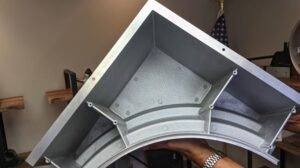Engineers are always looking for ways to reduce the weight of their final product. Lighter products mean reduced material costs, easy handling and transportation, and sometimes even improved product performance and efficiency!
Here are five ways you can reduce the weight of your metal casting.
Use a lightweight material, such as aluminum. Aluminum A356 is strong, yet lighter than other metals such as iron or zinc.
Aluminum has a high strength-to-weight ratio, so you can achieve a lighter product without compromising structural integrity.
Reduce excess material by using ribs and gussets in high stress areas.
For example, this large building-corner casting only weighs 20 pounds, thanks to smartly placed ribbing!

Proper fillets and radii can also reduce stress concentrations, eliminating the need for extra material.
Use hollow or semi-hollow sections to reduce material and weight. Sand cores or pull cores can be used to create internal cavities.
Find the wall thickness sweet spot between manufacturability and functionality. Casting walls should be thick enough for proper metal flow and solidification, but thin enough to eliminate unnecessary weight.
For permanent mold casting, we recommend at least 0.18 inch wall thickness, depending on the length of travel or distance the aluminum travels.
Consolidate your parts. Don’t add complexity that doesn’t serve a purpose!